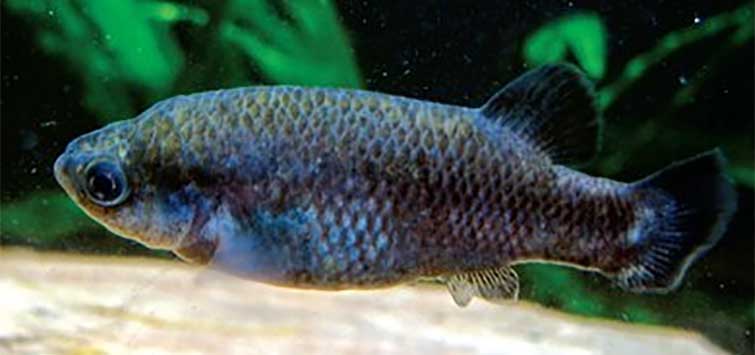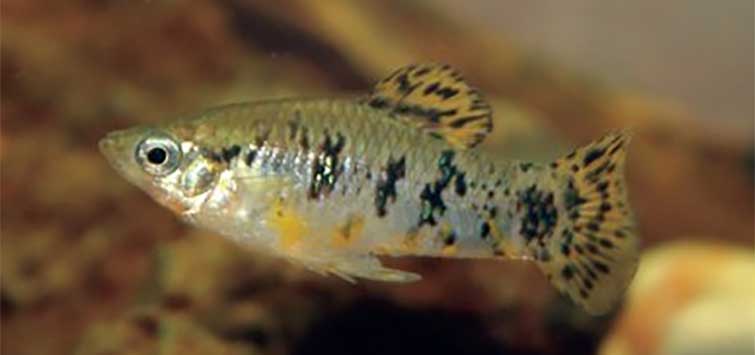Livebearers Unlimited: Catching Up On Characodon
Author: Rhonda Wilson
The characodons are my favorite goodeids. They’re a beautiful fish and certainly could contend as the most colorful of the goodeids. I first discovered the characodons from a photo in the Lothar Wischnath book Atlas of Livebearers of the World. My first characodons were the aquarium strain Characodon lateralis. These have been wonderful hardy fish with beautiful red males.
History and Biology
The genus Characodon was originally described in 1866 by Albert GÜnther, curator of the British Museum of Natural History. At that time Characodon lateralis was thought to be the only species in the genus. In 1986 Leonard Michael Smith and Robert Rush Miller described Characodon audax. They also recognized C. garmani as a distinct, though extinct, species. Our only knowledge of this fish comes from a single preserved female specimen collected in the late 1800s. Other populations of these fish may at some point in time also be described as distinct species.
Livebearing goodeids (there are two genera of egg-laying fish in a small area of California and Nevada that are considered as a subfamily) are found in the central uplands of Mexico. The characodons have a very small range in the state of Durango. The characodons are considered to be the most primitive of the goodeids and the closest relatives of the previously mentioned egg-laying goodeids.
General Care
Water Conditions
In the wild these fish live in various, mostly spring-fed, bodies of water, most of them quite small, with water temperatures ranging from about 68° to 75°F. Characodons haven’t been reported living in waters below 60°F, and they don’t fare well with high temperatures either; in the aquarium they should probably be kept in the 70° to 74°F range most of the time. The natural waters they live in also have a fairly high pH and are relatively hard. My tap water comes out of the tap at about 8.0 and settles to about 7.8 in the tanks, which makes it easy for me to keep these fish.
Feeding
Characodons are omnivorous. They enjoy live foods and can be feed flake food, but they also need to have a good portion of vegetable matter in their diets. I’ve always kept mine in well-planted aquariums. If they feel the need for a salad, there’s always something around to munch on. If kept in a non-planted aquarium, extra care must be given to ensure they have a well-rounded diet including green foods.
Information
When looking for information on these fish, you may find conflicting information. Some sources say they are very difficult, while others find them easy to maintain and breed. In my personal experiences I’ve found fish from some locations to be particularly difficult, while others seem to be fairly easy. As with any fish, the more research you do and the more care you take in setting up the proper home and foods for them, the better chance you will have of being successful. Of course tank maintenance is a crucial part of keeping any aquarium fish, and regular water changes are an important part of the process.
Aggression and Breeding
The characodons are easily sexed, with the males displaying more color than the females. I’ve read accounts of the males being aggressive enough to kill each other, but haven’t seen this in my fish. I have kept a pair in a 10-gallon tank but wouldn’t recommend keeping a group in anything smaller than 20 gallons. I generally keep most of my fish in species-only tanks and don’t remove the fry, so all ages are present. The characodons do chase each other around quite a bit, mostly males chasing the females, but I don’t see fin damage or stressed fish in my tanks when they’re kept this way.
Males
In a group tank, the alpha male or males tend to lose the dark spots on the sides of their bodies and become more deeply colored than the other males. Younger and lower-ranking males have some of the coloring that the alpha males have, but they also keep the dark spots that are present on the females. Male ranking in the tank doesn’t seem to keep the lower-rank males from chasing the females, but I have noticed the higher-ranking males go for the larger females. They seem to pair off according to the social order in the tank.
The male characodons seem to be like most livebearers in that they always seem to be interested in breeding. In a good breeding pair, the male seems like he is always at the female’s side.
Goodeids are also called “split-fins” because in the males the first few spines in the anal fins are shorter (this is called an andropodium). The andropodium is different than the gonopodium found in poeciliid males. While the gonopodium is used to transport the sperm to the female fish, the andropodium is thought to be used more as a grasping device to hold the female in place. It’s theorized that another muscular organ in the male delivers the sperm.
Females
Characodon female gestation can last as long as two months, ending when as many as 20 or more fry can be born. Most batches of fry are smaller. I’ve found that younger females generally have less, but larger, fry, and older females seem to have more, but smaller, fry. When the fry are born you may notice a strange structure hanging off them, like an umbilical cord. This is called the trophotaenia, and it serves somewhat the same purpose as the umbilical cord in mammals. Though it is not directly connected to the mother, it is used to deliver nourishment to the fry. The trophotaenia disappears within a few days after birth.
Females can be placed in separate tanks before birth or kept in a species tank with plenty of hiding places for the fry. The fry will eat smaller versions of pretty much whatever the parents are eating, and of course will also enjoy live foods including baby brine shrimp. Unlike the poeciliid females, the female goodeid must be inseminated again before she can have another batch of fry.
Species and Locations
C. lateralis is known as the rainbow goodeid. The aquarium strain is very colorful and has been quite hardy for me. I also keep the Los Barros (Ojo de Agua de San Juan) location, which has also been very easy for me, though these fish haven’t been as dark a red in coloration as the aquarium strain. Another location for C. lateralis that is available is Los Pinos.
C. audax was described in 1986. It’s commonly known as the black prince. The name refers to the beautiful black finnage these fish possess. The originally described C. audax came from El Ojo de Agua de Las Mujeres, near a town called El Toboso. I’ve tried these fish twice, and though I’ve gotten fry could never keep them going. Recently another Characodon from Guadalupe Aguilera has been determined to be of the genus audax, these fish are predominantly red. I did have the Guadalupe Aguilera characodons, but lost them last summer when my air conditioner gave out while we were on vacation. Before then I had good success with the fish.
Other locations available are Amado Nervo, Abraham Gonzales, and 27 de Noviembre. There still seems to be some debate as to whether these fish are lateralis, audax, or undescribed species. I have a tank of the Amado Nervo and the males haven’t been as colorful as the other characodons I’ve kept. They tend to be more yellow than the usual red of most of the other characodons.
A Bleak Future
The small bodies of water that characodons live in have not helped the fish in their struggle for survival. As industry and farming have increased, pollution and water usage are pushing these fish to the edge of extinction. In the case of C. garmani it already has.
The IUCN (International Union for Conservation of Nature and Natural Resources) Red List lists C. garmani as extinct, C. audax as vulnerable, and C. lateralis as endangered. Many scientists studying characodons feel the remaining species are critically endangered.
And a Small Hope
Time is running out for many of these fish in their native waters. If their interesting color and behavior don’t entice you to try these fish, perhaps the fact that aquarists may be one of their last best hopes at fending off total extinction will. These are wonderful fish, and not only can you just enjoy them as they are, but you can also feel good about providing a home for an animal that may soon not have one in the wild.
Guppy Corner
I got my first Giessen guppies in 1993. They were half-black reds and the most beautiful guppies I’d ever seen. The Giessen guppies have extra long fins, the most noticeable is the extra long anal fin in the females. Males also have long anal fins that interfere with their ability to breed. Usually a short-anal-finned male is bred with the long-anal-finned female. About half the fry will have short anal fins and the other half will have long.
Giessen guppies are named after the University of Giessen in Giessen, Germany. The guppies themselves were developed in Asia. So how did they get the name Giessen? I asked German aquarium author and guppy expert Harro Hieronimus.
Harro emailed me that the Giessens were in fact created in Singapore and then brought to Germany. There, Dr. W. Foerster and Drs. Annerose and Fritz Anders were in a group researching guppy genetics at Giessen, where some of these guppies ended up, and that’s how the guppies got the name.
Harro explained that an earlier long-fin guppy, called the Berlin guppy, has uncontrolled fin growth. The fins keep getting longer and eventually the fish will have problems swimming.
Harro also told me that only a few people in Europe and Asia breed Giessens, and they are not welcomed in the shows there.
Now, I do have to admit I don’t show or sell guppies, but I do keep them strictly for my own personal pleasure. I enjoy breeding them and trying to achieve the colors and finnage I prefer. I keep several tanks of Giessen guppies. Beauty is in the eye of the beholder, and to me these are beautiful fish—and they’re fun to keep!

.png?h=595&iar=0&w=2781&hash=5FD5E69473BCC22199FBFA2FB71B6033)



